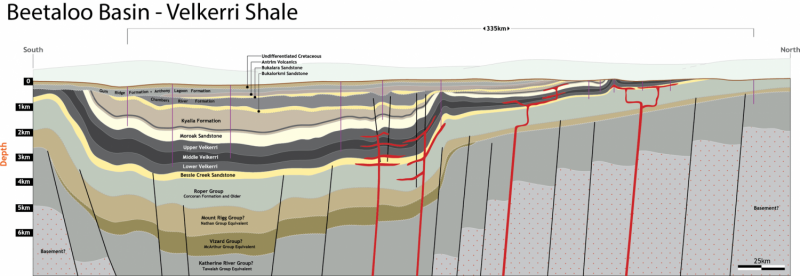A time capsule containing 118 trillion cubic feet of gas is buried in northern Australia

Two to three kilometres beneath the surface of Australia's Northern Territory sits buried energy. The layered rock formations known as the Velkerri Shale were recently estimated to contain over 118 trillion cubic feet of gas.
While these gas reserves are clearly large, what is really remarkable is their age. These rocks were deposited 1,400 million years ago, in an ocean known as the Roper Seaway. These rocks, and their encased oil and gas, are about a billion years older than rocks where oil and gas are usually found.
The molecules that make up the oil and gas – called hydrocarbons because they consist of hydrogen and carbon atoms – are the long-decomposed remains of dead bacteria that inhabited ancient oceans.
These are the most unconventional hydrocarbons yet discovered; "unconventional" because of the type of rock they're contained in, and their age. This antiquity gives us a rare chance to use the remains of the bacteria to examine the chemistry of the ancient oceans, the composition of the ancient atmosphere, and the nature of life 1,400 million years ago.
Ancient oceans
Recently we have learned a lot about Earth's ancient marine environment.
This has been achieved by analysing rare elements, particularly cerium (Ce) and molybdenum (Mo) extracted from the once-living organic matter within the Velkerri Shale. Ce and Mo act as indicators of how much oxygen was available in the oceans 1,400 million years ago. The studies reveal an ocean starved of oxygen, even in surface waters. At deeper depths this ocean was completely toxic, rich in hydrogen sulfide.
These results indicate that Earth's atmosphere at this time was oxygen-poor. In fact, it is likely that it contained less than 3% oxygen. Currently we enjoy 21% oxygen in Earth's atmosphere and a largely oxygenated ocean.
Further work by our colleagues has focused on extracting molecules of biological origin from the same rocks. These "biomarkers" have revealed an ocean dominated by bacteria.

But why is the age of the Velkerri Shale so unusual? It's got a lot to do with the unique sequence of events that need to occur to produce and preserve oil and gas.
How oil and gas forms underground
Oil and gas are produced from rocks known as black shales. These rocks contain high levels of organic matter (materials that were once living); in this case, the organic matter is the decomposed remains of bacteria.
To convert organic matter to oil or gas requires heat, but not too much: you need to delicately cook the rocks to temperatures between 60℃ and 160℃ for a few million years. You do this by burying the rocks.
Earth gets hotter as you go deeper, something miners know well. In fact, the deepest mine in the world (in South Africa) goes down 3.4 kilometres, and the rock temperatures down there are an incredible 60℃.
Oil and gas form when the rocks get a little deeper than this. These temperatures are often referred to as the oil and gas "window". If the organic matter does not reach this temperature window, oil and gas are not produced.
Avoiding colliding plates
The enemy of preserving ancient oil and gas is plate tectonics, or moving layers of rock at Earth's surface.
Much of the planet is sculpted by plate tectonics. In fact, major continental collisions happen quite episodically, during the assembly of supercontinents. These massive continental amalgamations occur in a regular 600-million-year cycle.
But if oil- and gas-bearing black shales find themselves at a plate margin, they often get buried too deeply, heating them too much and destroying them.
The fact that the Velkerri Shale contains vast quantities of oil and gas means that these rocks have not experienced temperatures above 160℃ for 1,400 million years. This is quite remarkable considering that Australia has been involved in major tectonic upheavals associated with the assembly of two supercontinents during this time, Rodinia and Pangaea.
Most of the oil and gas we use as an energy source comes from rocks less than 500 million years old, and the vast majority are less than 300 million years old. Young rocks haven't been around that long, so are less likely to have been sandwiched between colliding plates.
These young oil and gas reserves formed after the Cambrian explosion, at a time when plant and animal life was abundant on Earth.
Rethinking "Peak Oil"
The Velkerri Shale contains enough gas to power Australia for more than 90 years, at current consumption rates. While only a proportion of this gas would be recoverable, a resource estimate of 118 trillion cubic feet forms a large onshore unconventional shale gas reserve in a country soon to be the largest gas exporter in the world.
Oil and gas are non-renewable resources. The concept of "Peak Oil" or more broadly "Peak Hydrocarbons" refers to the point in time when the maximum rate of oil and gas extraction is reached. However, the technological development of unconventional oil and gas, and now the realisation that gas can be sourced from extremely old rocks, such as the Velkerri Shale, means that the arrival of "Peak Hydrocarbons" may be further delayed.
The development of unconventional oil and gas remains contentious, and well-informed public debate will ultimately decide whether such shale gas resources are developed.
If the Velkerri Shale moves from exploration to production, we will be making use of gas produced in a "slime world" that existed nearly a billion years before the first complex life on Earth evolved, where bacteria ruled the seas and the atmosphere was largely devoid of oxygen.
Provided by The Conversation
This article was originally published on The Conversation. Read the original article.![]()





















